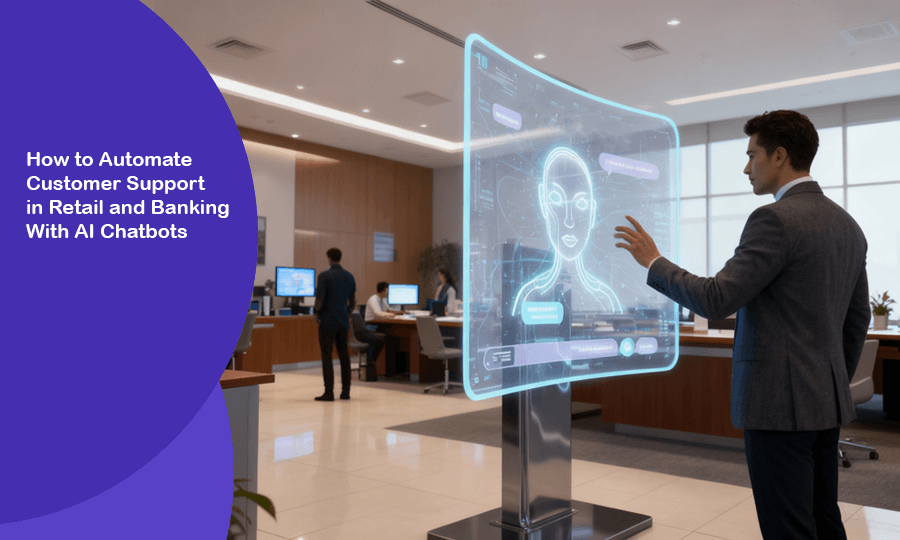In the sectors of retail and banking, automating customer support with AI can transform how businesses handle inquiries, resolve issues, and build loyalty. Tools like generative AI customer service and AI chatbots for ecommerce are key to this, offering instant responses and personalized assistance.
If you're curious about how do AI chatbots work or facing AI implementation challenges, this guide provides step-by-step advice on how to integrate AI into your business, covering AI integration services, AI data integration, and the benefits of AI in customer service.
From retail product queries to banking transaction support, automation can cut costs and boost efficiency.
Step 1: Assess Your Customer Support Needs and Choose the Right AI Tools
Begin by reviewing your current support processes in retail or banking to select suitable AI solutions. Identify pain points: Are customers waiting long for account info in banking, or product details in retail? Analyze data from your systems to spot where automation could help, like handling routine queries to free up staff, one of the main benefits of using chatbots.
Prioritize features such as natural language processing for query understanding, integration with databases for real-time data, and scalability for peak times. In banking, focus on secure AI for sensitive info; in retail, look for visual or multilingual capabilities to overcome AI integration challenges.
Partner with trusted chatbot development companies that provide chatbot development services, AI chatbot development services, or custom chatbot development services.
A standout example is VisualSearchAI from Uran Company. This AI-driven visual search tool allows users to search for products or information using images, employing advanced computer vision algorithms and machine learning to analyze uploads and match them to a database for accurate results. Developed in approximately 8 weeks with technologies like Algolia, CSS, GCP Cloud Storage, Google Vision API, Laravel, Next.js, PostgreSQL, Stripe API, and Tailwind by a team consisting of 1 AI/ML specialist, 1 team lead, 1 frontend developer, 1 backend developer and QA team, it's perfect for retail support by enabling quick product identification via photos, reducing manual searches. This initial choice ensures smooth generative AI integration tailored to your needs.
Step 2: Implement AI into Your Customer Support Systems
With tools selected, integrate them into your platforms, whether websites, apps, or call centers. Use APIs for AI data integration, linking to your CRM, transaction logs in banking, or inventory in retail, to deliver precise responses. This is crucial for how to integrate AI in website or app setups without major disruptions.
Customize workflows: For banking, set up AI to verify identities and guide transfers; in retail, enable chatbots to suggest alternatives based on queries. Incorporate generative AI customer service for dynamic, context-aware replies, and for mobile access, use chatbot app development services or AI chatbot app development services.
Test rigorously: Launch in phases, simulate scenarios, and address issues like data accuracy to tackle AI implementation challenges. This implementation highlights the benefits of AI in customer service, such as 24/7 availability and faster resolutions, making support more proactive.

Step 3: Optimize AI for Enhanced Performance
To maximize automation, refine your AI based on early data. Monitor interactions to improve accuracy, fine-tune models for better understanding of slang in retail chats or technical terms in banking, aligning with how do AI chatbots work effectively.
Add advanced features: Integrate visual search for retail troubleshooting or voice options for banking accessibility. For ecommerce elements in retail, deploy AI chatbots for ecommerce to handle orders seamlessly.
Track metrics like query resolution speed and run A/B tests on response tones. These tweaks can reduce support tickets by 40-60%, demonstrating the real benefits of using chatbots while smoothing generative AI integration hurdles.
Step 4: Scale and Maintain Your AI System for Long-Term Success
As usage grows, ensure your AI scales across branches or online channels. Opt for cloud-based solutions to manage high volumes, and expand with features like multi-channel support through custom chatbot development services.
Maintenance is key: Regularly update databases, retrain AI with new data, and audit for compliance in banking. Rely on AI integration services to handle updates without downtime.
Consider the AI chatbot development cost, ranging from $5,000 for basic setups to $100,000+ for advanced, secure systems including customizations and ongoing support. Collaborating with experienced chatbot development companies helps optimize this investment for sustained value.
Step 5: Measure Success and Iterate
Finally, evaluate your automation efforts to keep improving. Monitor key outcomes like reduced wait times, higher satisfaction scores, and cost savings, essential signs of successful AI integration.
Collect feedback through surveys or analytics, then iterate: Adjust based on insights, perhaps adding more AI for predictive support. This ongoing cycle ensures your system adapts, fully leveraging how to integrate AI into business for better retail and banking experiences.
By following these steps, retail and banking businesses can automate customer support effectively, overcoming challenges and unlocking efficiency, showing the power of AI to elevate service in these dynamic fields.
Relevant Articles







































